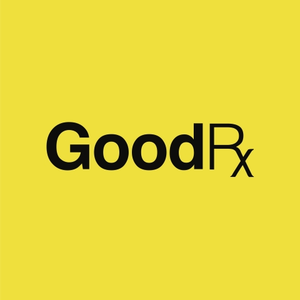
Tandem Diabetes (TNDM)
Tandem Diabetes is up against the odds. Its poor sales growth shows demand is soft and its negative returns on capital suggest it destroyed value.― StockStory Analyst Team
1. News
2. Summary
Why We Think Tandem Diabetes Will Underperform
With technology that automatically adjusts insulin delivery based on continuous glucose monitoring data, Tandem Diabetes Care (NASDAQ:TNDM) develops and manufactures automated insulin delivery systems that help people with diabetes manage their blood glucose levels.
- Earnings per share fell by 18.5% annually over the last five years while its revenue grew, showing its incremental sales were much less profitable
- Persistent adjusted operating margin losses suggest the business manages its expenses poorly
- Negative EBITDA restricts its access to capital and increases the probability of shareholder dilution if things turn unexpectedly


Tandem Diabetes’s quality is insufficient. There are more appealing investments to be made.
Why There Are Better Opportunities Than Tandem Diabetes
High Quality
Investable
Underperform
Why There Are Better Opportunities Than Tandem Diabetes
Tandem Diabetes’s stock price of $22.48 implies a valuation ratio of 32.7x forward EV-to-EBITDA. We consider this valuation aggressive considering the business fundamentals.
There are stocks out there featuring similar valuation multiples with better fundamentals. We prefer to invest in those.
3. Tandem Diabetes (TNDM) Research Report: Q3 CY2025 Update
Diabetes technology company Tandem Diabetes Care (NASDAQ:TNDM) reported revenue ahead of Wall Streets expectations in Q3 CY2025, with sales up 2.2% year on year to $249.3 million. Its GAAP loss of $0.31 per share was 3.6% above analysts’ consensus estimates.
Tandem Diabetes (TNDM) Q3 CY2025 Highlights:
- Revenue: $249.3 million vs analyst estimates of $236 million (2.2% year-on-year growth, 5.6% beat)
- EPS (GAAP): -$0.31 vs analyst estimates of -$0.32 (3.6% beat)
- Operating Margin: -9.2%, up from -10.7% in the same quarter last year
- Sales Volumes fell 4.8% year on year (24.7% in the same quarter last year)
- Market Capitalization: $991.2 million
Company Overview
With technology that automatically adjusts insulin delivery based on continuous glucose monitoring data, Tandem Diabetes Care (NASDAQ:TNDM) develops and manufactures automated insulin delivery systems that help people with diabetes manage their blood glucose levels.
Tandem's flagship products include the t:slim X2 insulin pump and the newer, smaller Tandem Mobi system. Both devices feature the company's Control-IQ technology, an advanced hybrid closed-loop system that automatically adjusts insulin delivery based on readings from compatible continuous glucose monitors (CGMs). This technology helps users maintain their blood glucose within target ranges by increasing, decreasing, or suspending insulin delivery as needed, and can even deliver automatic correction doses when glucose levels rise too high.
The company's pumps are designed with user experience in mind, featuring touchscreen interfaces, Bluetooth connectivity, and software that can be updated remotely through a personal computer. This allows users to access new features without replacing their hardware. For example, existing t:slim X2 users can update their pumps to integrate with newer CGM sensors as they become available.
Tandem's revenue comes primarily from selling insulin pumps and the disposable supplies needed to use them, including insulin cartridges and infusion sets that need to be replaced every few days. A patient might use a Tandem pump to manage their diabetes by wearing the device (about the size of a small smartphone for the t:slim X2 or a car key fob for the Mobi), which delivers insulin through a thin tube connected to an infusion set attached to their body.
The company has expanded its CGM integration partnerships to include both Dexcom and Abbott sensors, giving patients more options for customizing their diabetes management systems. Tandem also offers digital tools like the Tandem Source data management platform, which allows users and healthcare providers to visualize diabetes data and identify trends.
Beyond its current product lineup, Tandem is developing new innovations including a tubeless patch pump option, extended-wear infusion sets, and enhancements to its Control-IQ algorithm. The company is also working to expand its addressable market by conducting clinical trials to support the use of its technology in people with type 2 diabetes who require intensive insulin therapy.
4. Healthcare Technology for Patients
The consumer-focused healthcare technology sector leverages digital platforms to make healthcare more accessible and affordable, offering services like telemedicine and prescription discounts. Looking forward, growth is supported by increasing consumer comfort with telehealth and the demand for cost-saving tools amidst rising healthcare expenses. AI-powered diagnostics and personalized digital care also present significant opportunities. However, the sector faces headwinds from heightened competition as large technology and established healthcare companies expand their digital presence.
Tandem Diabetes Care competes with Insulet Corporation (NASDAQ:PODD), which makes the tubeless Omnipod insulin delivery system, Medtronic (NYSE:MDT), a medical device giant with a diabetes division that produces insulin pumps, and privately-held Ypsomed, a European medical technology company that manufactures insulin pumps and injection systems.
5. Revenue Scale
Larger companies benefit from economies of scale, where fixed costs like infrastructure, technology, and administration are spread over a higher volume of goods or services, reducing the cost per unit. Scale can also lead to bargaining power with suppliers, greater brand recognition, and more investment firepower. A virtuous cycle can ensue if a scaled company plays its cards right.
With just $1.01 billion in revenue over the past 12 months, Tandem Diabetes is a small company in an industry where scale matters. This makes it difficult to build trust with customers because healthcare is heavily regulated, complex, and resource-intensive.
6. Revenue Growth
A company’s long-term sales performance is one signal of its overall quality. Even a bad business can shine for one or two quarters, but a top-tier one grows for years. Thankfully, Tandem Diabetes’s 18.1% annualized revenue growth over the last five years was impressive. Its growth beat the average healthcare company and shows its offerings resonate with customers.
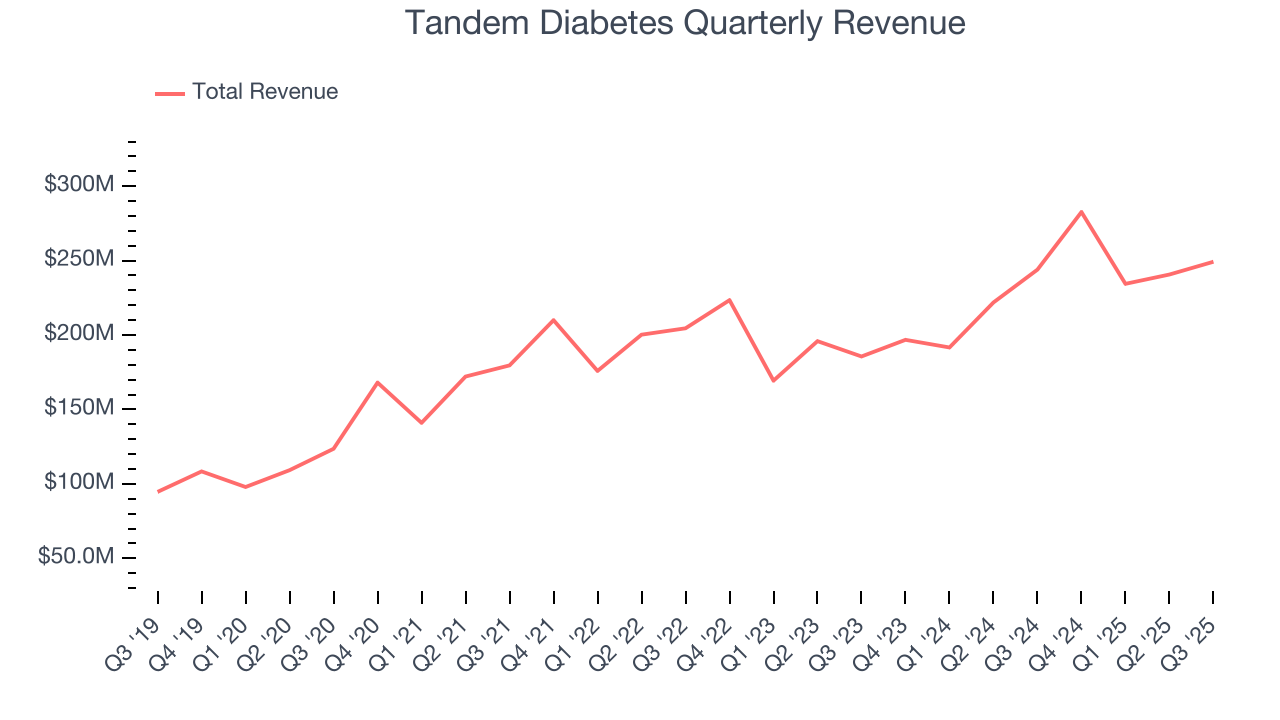
We at StockStory place the most emphasis on long-term growth, but within healthcare, a half-decade historical view may miss recent innovations or disruptive industry trends. Tandem Diabetes’s annualized revenue growth of 14% over the last two years is below its five-year trend, but we still think the results suggest healthy demand. 
Tandem Diabetes also reports its number of pump shipments, which reached 20,000 in the latest quarter. Over the last two years, Tandem Diabetes’s pump shipments averaged 4.4% year-on-year growth. Because this number is lower than its revenue growth, we can see the company benefited from price increases. 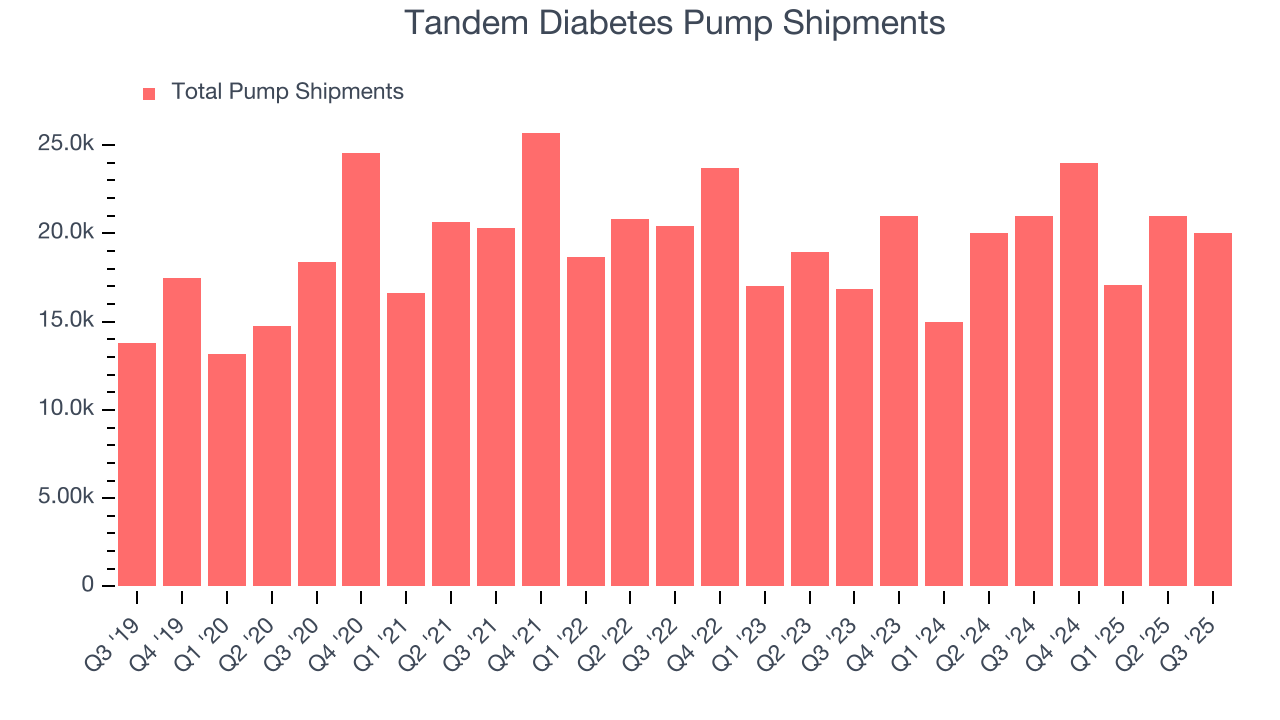
This quarter, Tandem Diabetes reported modest year-on-year revenue growth of 2.2% but beat Wall Street’s estimates by 5.6%.
Looking ahead, sell-side analysts expect revenue to grow 6.5% over the next 12 months, a deceleration versus the last two years. Still, this projection is above average for the sector and indicates the market is forecasting some success for its newer products and services.
7. Adjusted Operating Margin
Adjusted operating margin is an important measure of profitability as it shows the portion of revenue left after accounting for all core expenses – everything from the cost of goods sold to advertising and wages. It’s also useful for comparing profitability across companies because it excludes non-recurring expenses, interest on debt, and taxes.
Tandem Diabetes’s high expenses have contributed to an average adjusted operating margin of negative 10% over the last five years. Unprofitable healthcare companies require extra attention because they could get caught swimming naked when the tide goes out. It’s hard to trust that the business can endure a full cycle.
Looking at the trend in its profitability, Tandem Diabetes’s adjusted operating margin decreased by 23.6 percentage points over the last five years. The company’s two-year trajectory also shows it failed to get its profitability back to the peak as its margin fell by 7.4 percentage points. This performance was poor no matter how you look at it - it shows its expenses were rising and it couldn’t pass those costs onto its customers.
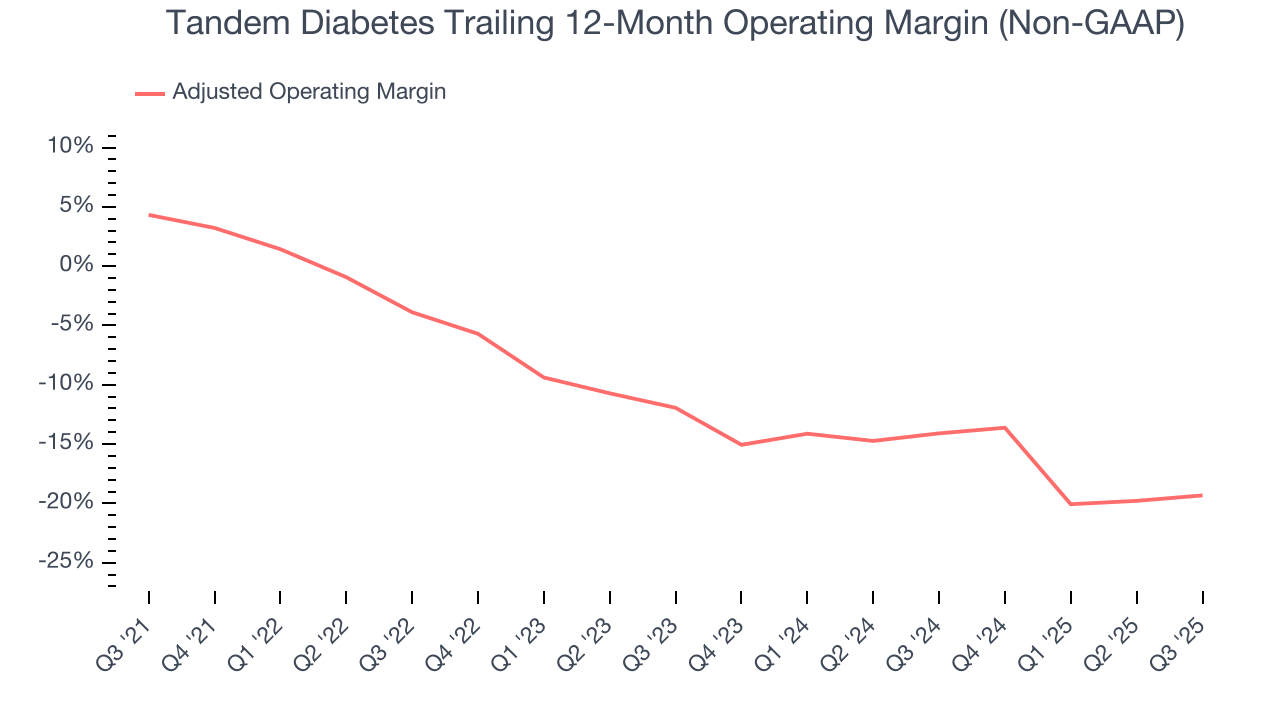
Tandem Diabetes’s adjusted operating margin was negative 9.2% this quarter.
8. Earnings Per Share
We track the long-term change in earnings per share (EPS) for the same reason as long-term revenue growth. Compared to revenue, however, EPS highlights whether a company’s growth is profitable.
Tandem Diabetes’s earnings losses deepened over the last five years as its EPS dropped 30.4% annually. We tend to steer our readers away from companies with falling EPS, where diminishing earnings could imply changing secular trends and preferences. If the tide turns unexpectedly, Tandem Diabetes’s low margin of safety could leave its stock price susceptible to large downswings.
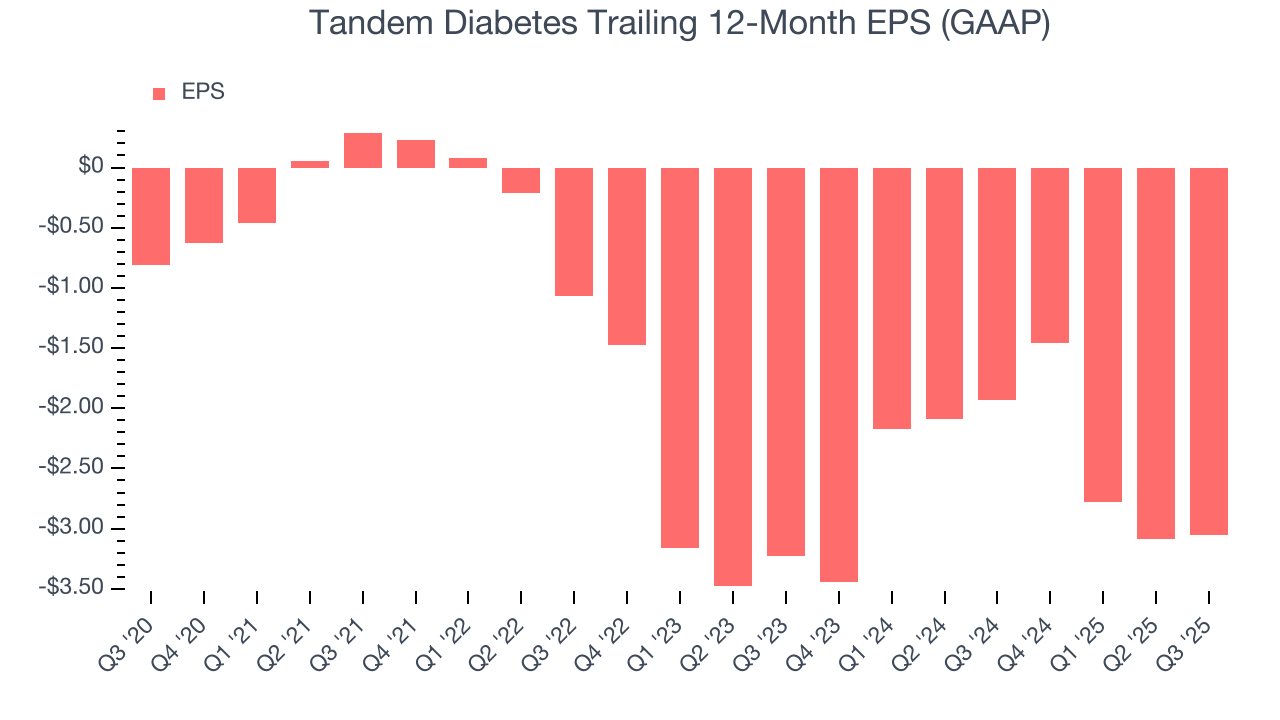
In Q3, Tandem Diabetes reported EPS of negative $0.31, up from negative $0.35 in the same quarter last year. This print beat analysts’ estimates by 3.6%. Over the next 12 months, Wall Street expects Tandem Diabetes to improve its earnings losses. Analysts forecast its full-year EPS of negative $3.05 will advance to negative $1.02.
9. Cash Is King
If you’ve followed StockStory for a while, you know we emphasize free cash flow. Why, you ask? We believe that in the end, cash is king, and you can’t use accounting profits to pay the bills.
Tandem Diabetes broke even from a free cash flow perspective over the last five years, giving the company limited opportunities to return capital to shareholders.
Taking a step back, we can see that Tandem Diabetes’s margin dropped by 17 percentage points during that time. Almost any movement in the wrong direction is undesirable because of its already low cash conversion. If the trend continues, it could signal it’s in the middle of a big investment cycle.
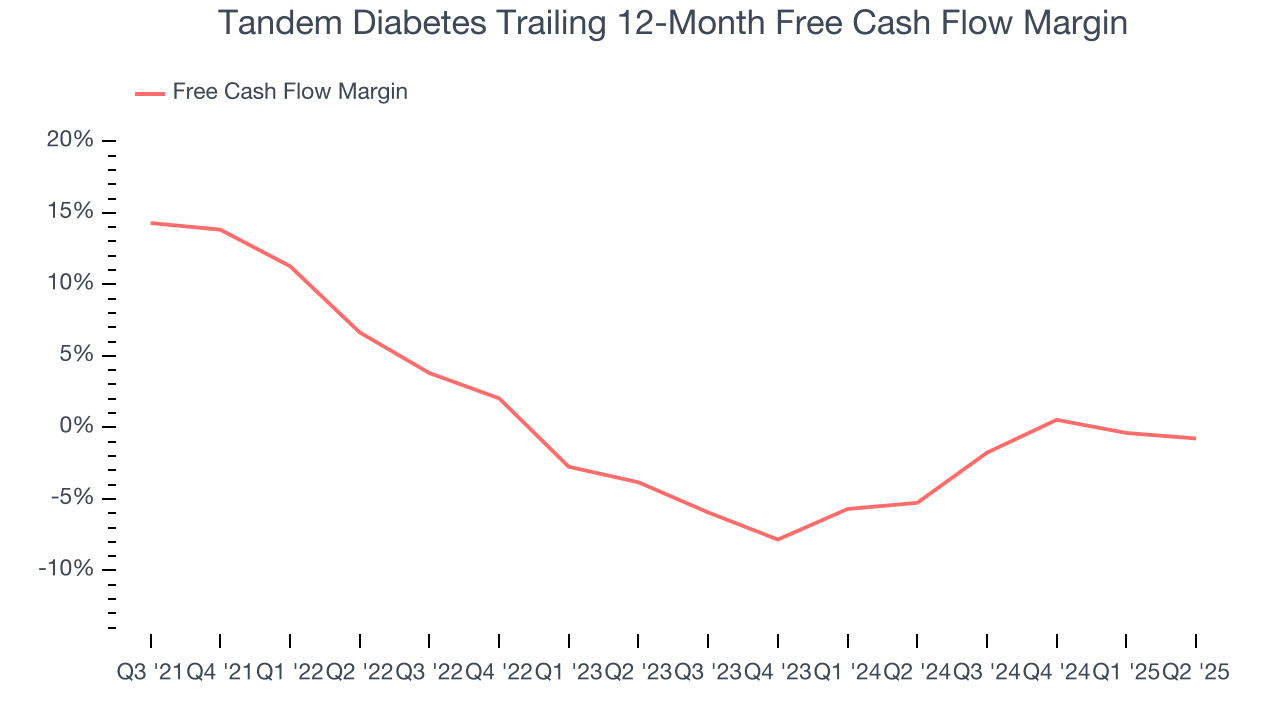
10. Return on Invested Capital (ROIC)
EPS and free cash flow tell us whether a company was profitable while growing its revenue. But was it capital-efficient? Enter ROIC, a metric showing how much operating profit a company generates relative to the money it has raised (debt and equity).
Tandem Diabetes’s five-year average ROIC was negative 46.7%, meaning management lost money while trying to expand the business. Its returns were among the worst in the healthcare sector.
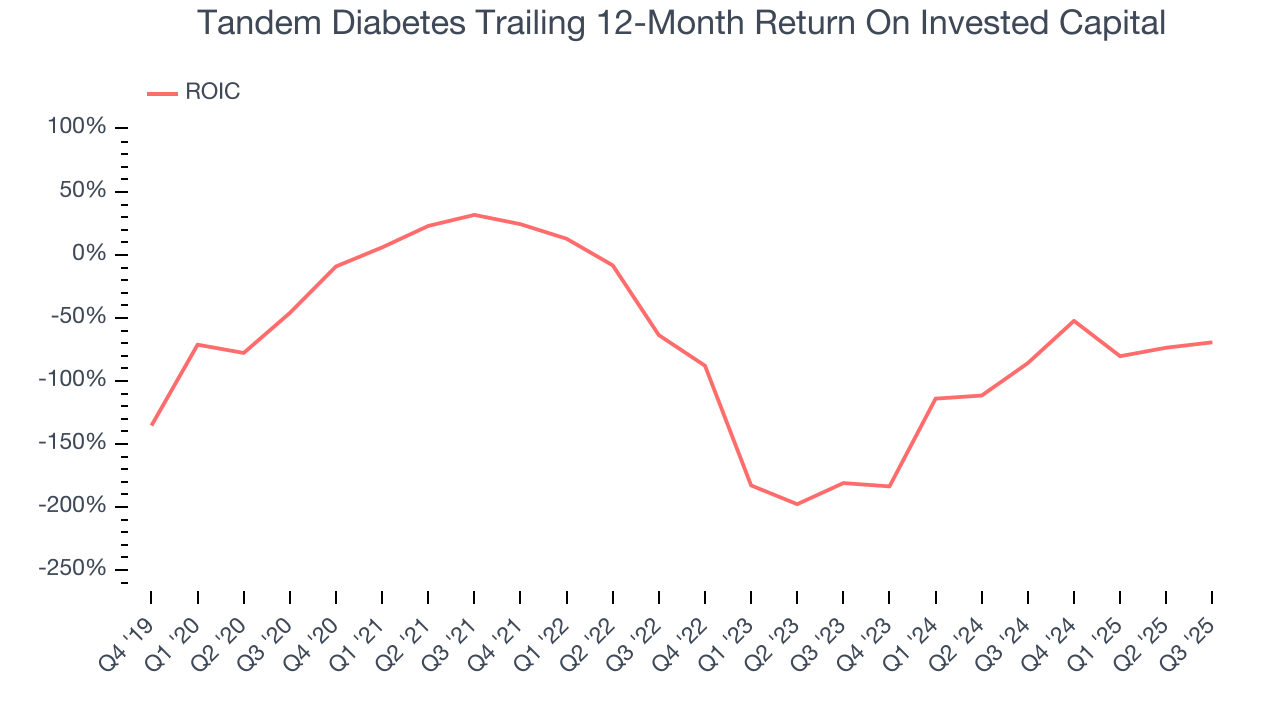
We like to invest in businesses with high returns, but the trend in a company’s ROIC is what often surprises the market and moves the stock price. Over the last few years, Tandem Diabetes’s ROIC has unfortunately decreased significantly. Paired with its already low returns, these declines suggest its profitable growth opportunities are few and far between.
11. Balance Sheet Risk
Debt is a tool that can boost company returns but presents risks if used irresponsibly. As long-term investors, we aim to avoid companies taking excessive advantage of this instrument because it could lead to insolvency.
Tandem Diabetes posted negative $76.74 million of EBITDA over the last 12 months, and its $449.3 million of debt exceeds the $319.1 million of cash on its balance sheet. This is a deal breaker for us because indebted loss-making companies spell trouble.
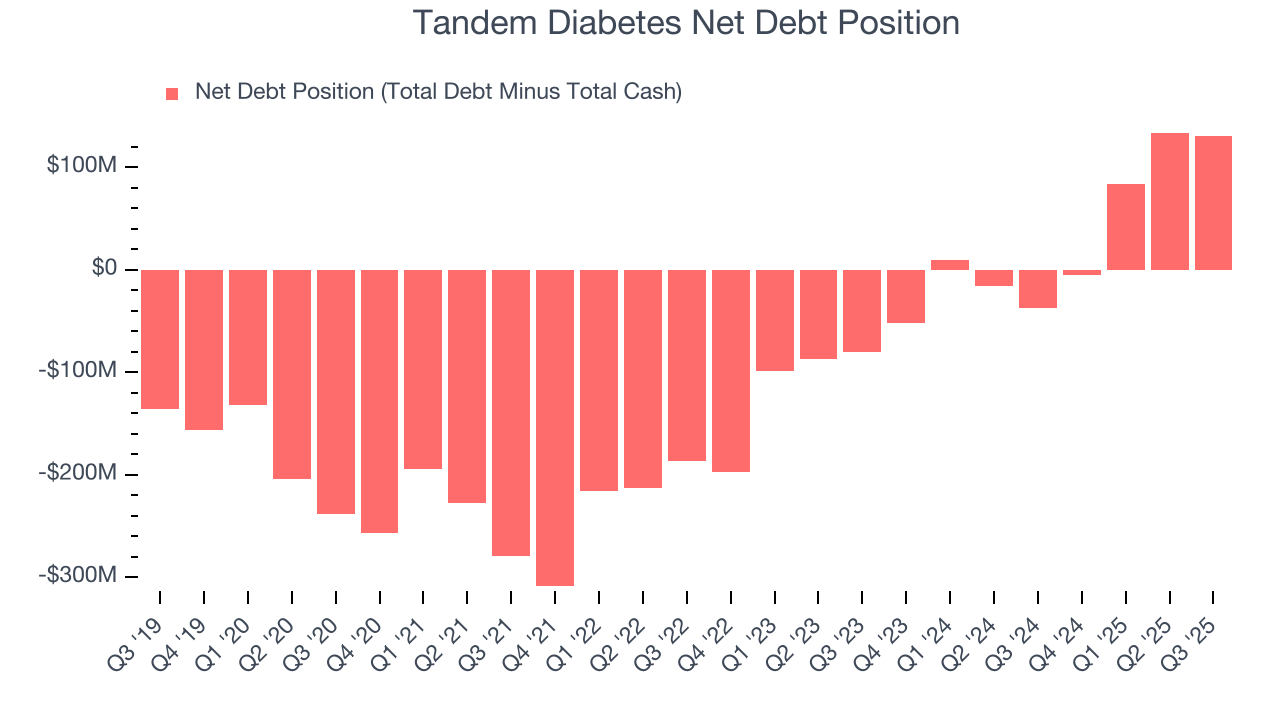
We implore our readers to tread carefully because credit agencies could downgrade Tandem Diabetes if its unprofitable ways continue, making incremental borrowing more expensive and restricting growth prospects. The company could also be backed into a corner if the market turns unexpectedly. We hope Tandem Diabetes can improve its profitability and remain cautious until then.
12. Key Takeaways from Tandem Diabetes’s Q3 Results
We were impressed by how significantly Tandem Diabetes blew past analysts’ revenue expectations this quarter. We were also glad its EPS outperformed Wall Street’s estimates. Zooming out, we think this was a good print with some key areas of upside. The stock traded up 17.5% to $15.65 immediately following the results.
13. Is Now The Time To Buy Tandem Diabetes?
Updated: December 24, 2025 at 11:08 PM EST
Before deciding whether to buy Tandem Diabetes or pass, we urge investors to consider business quality, valuation, and the latest quarterly results.
We see the value of companies making people healthier, but in the case of Tandem Diabetes, we’re out. Although its revenue growth was impressive over the last five years, it’s expected to deteriorate over the next 12 months and its diminishing returns show management's prior bets haven't worked out. On top of that, the company’s relatively low ROIC suggests management has struggled to find compelling investment opportunities.
Tandem Diabetes’s EV-to-EBITDA ratio based on the next 12 months is 32.7x. At this valuation, there’s a lot of good news priced in - we think there are better stocks to buy right now.
Wall Street analysts have a consensus one-year price target of $24.81 on the company (compared to the current share price of $22.48).



